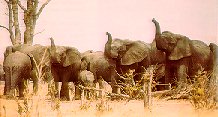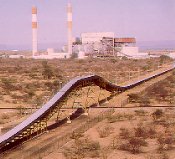


IN this, its second quarter-century of independence, Botswana can look back with pride upon its accomplishments and, at the same time, can look forward with comfidence to further developments. The country's national principles of democracy, unity and self reliance have been successfully implemented to maintain positive growth and, both in seeking to cope with its disadvantages and in emphasising its advantages, employers and employed are joined together in the effort to make 'Enterprise Botswana' a going concern. In a global economy becoming increasingly inter-dependent, Botswana is looking to active participation.
The Okavango Delta - a landscape of flood plains.
Although it is a landlocked country, its very position gives Botswana a competitive edge for, lying as it does at the centre of the southern African region, it has relatively easy access to all regional markets amd is thus able to draw on regional resources relatively easily.
LOCATION AND TOPOGRAPHY
Located in southern Africa, with Namibia (in the west and north), Zambia and Zimbabwe (in the north-east), and South Africa (in the east and south) as neighbours, the Republic of Botswana is a relatively flat country approximately 582000 square kilometres in area.
The eastern portion contains the highest and lowest points (almost 1500 metres and about 500 metres, respectively), with hills, valley, and rocky outcrops. The flat, vast western portions is semi-arid with rocky outcrops. Two -third of the country is characterised by gently undulating, sandy plains, with the central portion a shallow basin. One of southern Africa's longest rivers, the Okavango, flows through the country, fanning out into a delta of some 15000 square kilometres to form a uniqueenvironment with a myriad of water channels.
The Kgalagadi (or Kalahari) Desert occupies approximately 80 percent
of the country, with valleys and pans atched across the landscape.
Sowa Pan - spoonbills at the Nata River Mouth.

CLIMATE AND RAINFALL
With an average of some 1000 metres above sea level, the area experiences a wide range of temperatures, varying from an acerage daily maximum of 33 C in January, to -7 C in the southern part of the country. Winter begins in May, with July being the coldest month and October and November sometimes extremely hot.
Rainfall is erratic and sporadic, ranging from 250 milimetres per year in the south-west to over 600 milimetres in the north-east. (An interesting point is that the unit of currency, the Pula, takes its name from a traditional greeting which, approximately fot this land of great thirst, means 'rain'.) The main rainy season occurs in the summer months between November and March.
An elephant herd on the banks of the Kwai River.


NATURAL BEAUTY
A land of unique natural beauty, Botswana can be regarding as
one of the great holiday destinations in the world - strikingly
rugged wilderness areas with an immense variety of wildlife, the
fascinating complexity of an unusual mix of bird species - all
these are Botswana's unflaunted riches. Most of the country is
covered by savannah, and indigenous trees include rhe mopani,
camel thorn and baobab.
Zebra herd standing in long grass.

MINERAL WEALTH
Of those treasures that do lie buried, the mineral wealth of the
country is the major stimulus behind its rapid economic growth,
its extend still to be fully realised, with layers of untold thickness
still to be laid bare. Igneous activity has occured throughout
the country's geological history, the most economically significant
being the kimberlite pipes with their wealth of diamonds.
A conveyor at Morupule Colliery carries coal from the mine to the power station.
PEOPLE
As early as the 16th century Tswana communities entered the country and a system of incorporation was begun with absorption of the shona-speakers. Initially called Bechuanaland, the country was declared a British protectorate in the late 1880s, and it became independent in 1966, with the constitution providing for a republican form of government. Proud people, with a great respect for their nationality and traditions, the Batswana, as they are known today, include a number of ethnic groups dominated by those who are Setswana-speaking. Most of the population lives in the more fertile eastern region in the Limpopo River catchment area. Setswana is the national language, although English is the official medium used in business and most governmental affairs.
The nation's human resources are considered its principal competitive edge, its people perhaps the most precious asset. The reasonably well educated and trained labour force is supplemented with expatriate skills in areas in which Batswana are in short supply. The percentages enrolled in secondary and tertiary education continue to increase, with Batswana taking pride in performing their work efficiently and productively.

 go back
go back